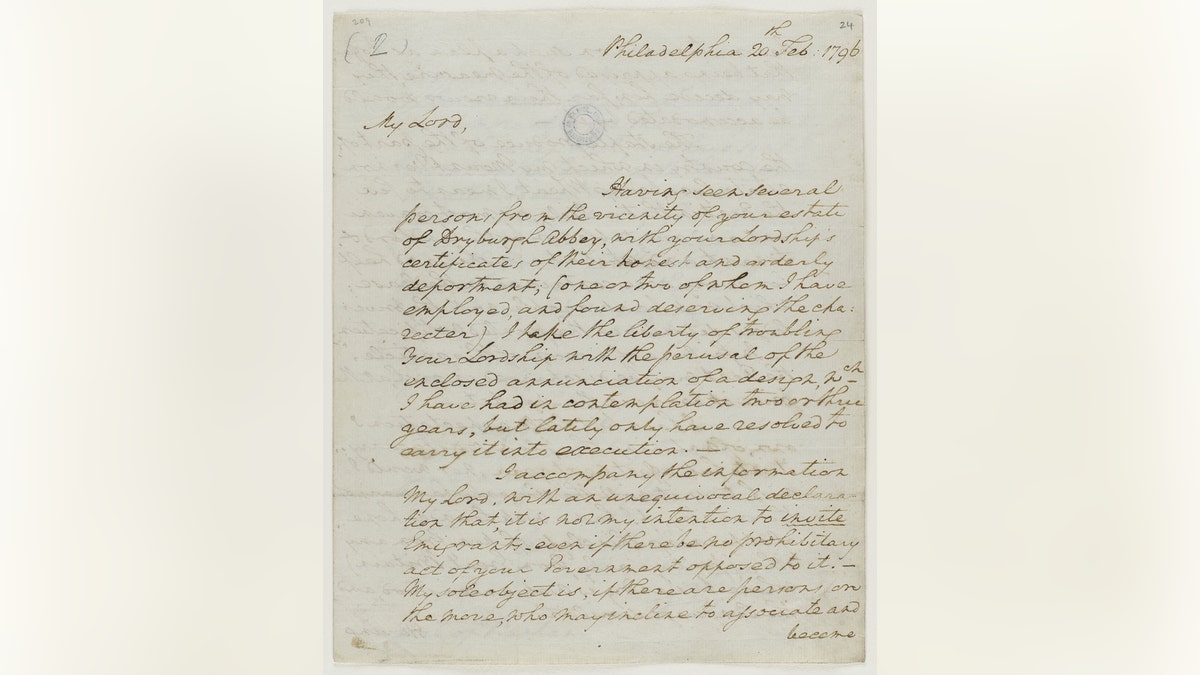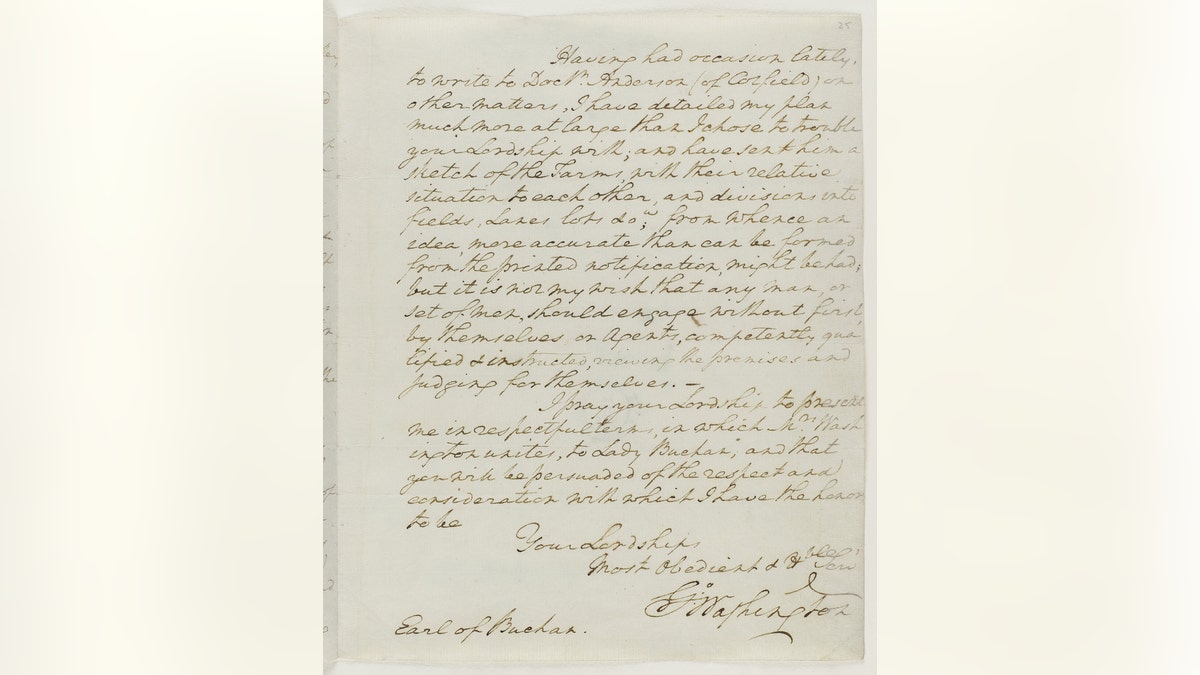Fox News Flash top headlines for Feb. 25
Fox News Flash top headlines are here. Check out what's clicking on Foxnews.com.
A 224-year-old letter from President George Washington to a Scottish nobleman in which he touches on agriculture and farming has surfaced.
Written on Feb. 20, 1796, the letter was addressed to David Erskine, 11th Earl of Buchan, a distant relative of Washington's who lived in the Scottish Borders. The two exchanged 18 letters altogether, mostly about farming and agriculture.
The three-page letter, written by Washington himself, is exemplary of him as a businessman. The contents of the letter show Washington was looking to diversify his holdings as he looked to grow wheat as opposed to tobacco and move on from enslaved labor and use tenant farmers. Washington had stopped growing tobacco in the 1760s.

A handwritten letter, sent by George Washington to a Scottish nobleman on Feb. 20, 1796, has shed light on the U.S. President's life away from public office. (Credit: SWNS)
GEORGE WASHINGTON LETTER ON GOD AND THE CONSTITUTION SURFACES
The letter reads in its entirety:
“My Lord,
“Having seen several persons from the vicinity of your estate of Dryburgh Abbey, with your Lordship’s certificates of their honest and orderly deportment; (one or two of whom I have employed, and found deserving the charecter) I take the liberty of troubling Your Lordship with the perusal of the enclosed annunciation of a design, wch I have had in contemplation two or three years, but lately only have resolved to carry it into execution.
“I accompany the information My Lord, with an unequivocal declaration that, it is not my intention to invite Emigrants—even if there be no prohibitary act of your Government opposed to it.
"My sole object is, if there are persons on the move, who may incline to associate and become tenants on such a plan as I offer, that being apprised of the measure, they may decide how far their views would be accomodated by it.
“The staple produce of the part of the country in which my Mount Vernon estate lyes, being Wheat, I mean to fix the Rent in that article, as most convenient and equitable for both Landlord & tenant; and I set it at a bushel and half for every acre contained in the lease; which will be all arable, with the priviledges detailed in the printed notification.
"In failure of a crop of this article, the Rent may be discharged in cash, at the price it bears in the Market.
“I have but little expectation I own, of maturing this plan so as to carry it into full effect next year; nor would I wish to do it with the slovenly farmers of this country, if I had a well founded hope of obtaining this class of Men from any other (particularly from Great Britain) where husbandry is well understood, and the language similar.
“Having had occasion lately, to write to Doctr Anderson (of Cotfield) on other matters, I have detailed my plan much more at large than I chose to trouble your Lordship with; and have sent him a sketch of the Farms, with their relative situation to each other, and divisions into fields, Lanes lots &ca; from whence an idea, more accurate than can be formed from the printed notification, might be had;2 but it is not my wish that any man, or set of men, should engage without first, by themselves or Agents, competently qualified & instructed, viewing the premises and judging for themselves.
“I pray your Lordship to present me in respectful terms, in which Mrs Washington unites, to Lady Buchan; and that you will be persuaded of the respect and consideration with which I have the honor to be Your Lordships Most Obedient & Hble Servt
“Go: Washington”.
Housed in the archives at the University of Edinburgh after it was donated in the 1870s by Sir David Lang, the letter was part of the "social network" at the time, according to University of Edinburgh American History professor Frank Cogliano.

The Founding Father was a year away from stepping down as president when he sent the note to David Erskine, 11th Earl of Buchan, who lived in the Scottish Borders. The pals were distant relatives and exchanged around 18 letters, mostly about agriculture. (Credit: SWNS)

The three-page letter, written on Feb. 20, 1796 in Philadelphia, described American farmers as ‘slovely’ and indicates Washington’s move to grow wheat rather than tobacco plants. (Credit: SWNS)
“The Enlightenment is often referred to as a ‘Republic of Letters’ and exchanges such as those between Washington and Buchan were the social networks of their day – not only swapping ideas but advertising opportunities," Cogliano said in a statement. “How familiar it seems to us today.”
“There is something quite compelling about the tangible nature of the original, created two days prior to Washington’s 64th birthday before making its way to Scotland," archives manager at the University of Edinburgh, Rachel Hosker, added. “It enables us to imagine him writing it, and allows us to consider the private individual in context.”
Memorabilia from Washington, who died in 1799 at his estate in Mount Vernon, continues to be a source of fascination for collectors.
In November 2017, a 235-year-old panoramic painting revealed the only known wartime depiction of George Washington’s Revolutionary War field tent. The previously unidentified painting was spotted by curators from the Museum of the American Revolution, who purchased it at Heritage Auctions. The painting shows hundreds of military tents amid the rolling landscape of the Hudson Valley, with Washington’s tent perched upon a hilltop.
In December 2017, a jewel-encrusted medal owned and worn by Washington went on display at the Museum of the American Revolution in Philadelphia. Commissioned by officers of the French Navy, the gold and silver medal is embedded with almost 200 diamonds, rubies and emeralds. It was presented to Washington in May 1784 at Philadelphia’s City Tavern near the current Museum of the American Revolution.
The headquarters flag used by Washington during the Revolutionary War went on display in Philadelphia in May 2018, marking its first public appearance in the city since the war itself. Adorned with 13 six-pointed stars to represent the original 13 colonies, the artifact is thought to be the earliest existing 13-star American flag.
A lock of his hair was sold at auction in January 2019. One month later, a letter on God and the Constitution written by the Founding Father was sold at auction.
CLICK HERE TO GET THE FOX NEWS APP
Fox News' James Rogers contributed to this story.

